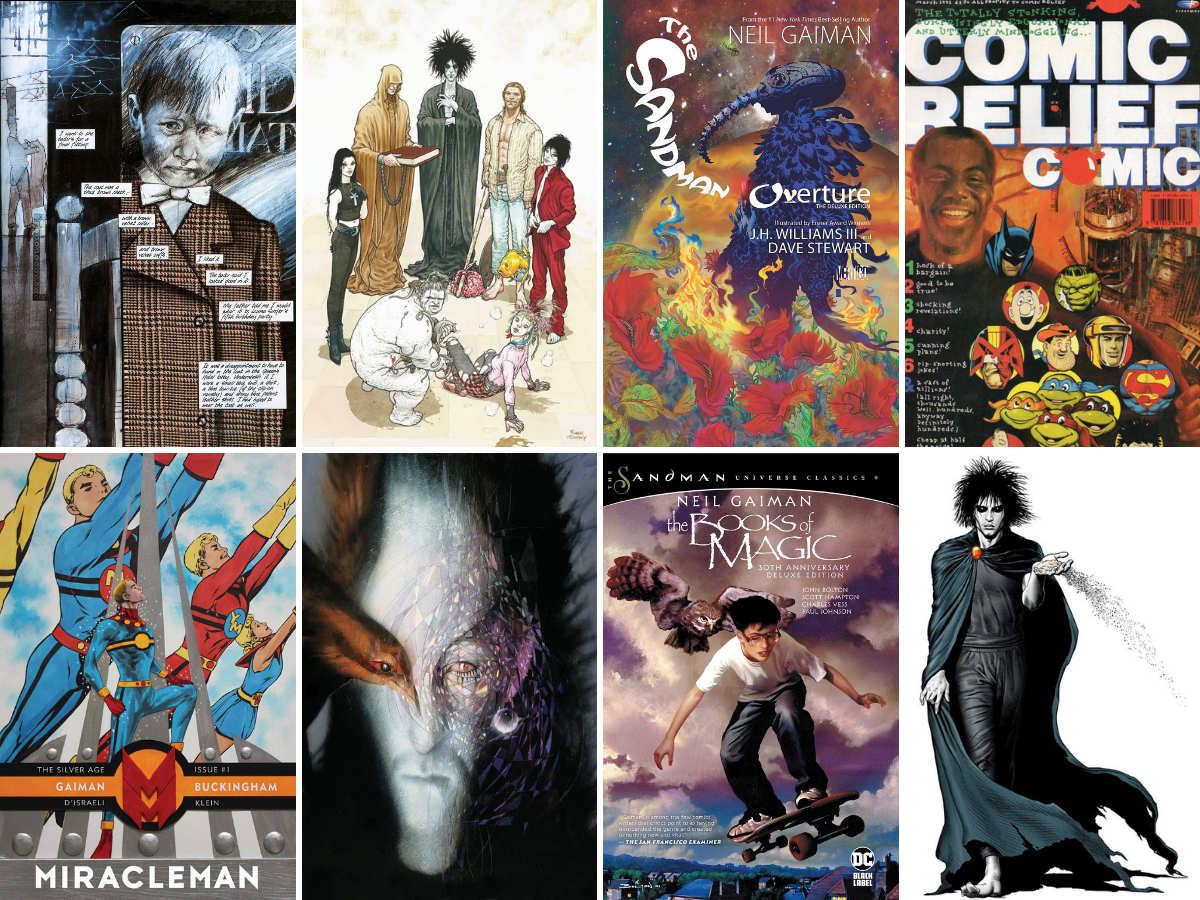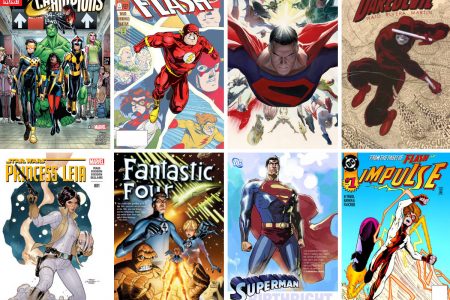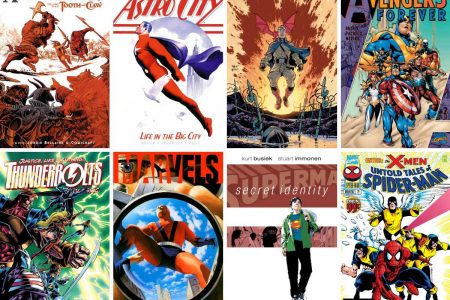When I started this recurring post idea, of discussing my favourite comic books by a particular writer, the list was based on a post where I discussed the creators with the most comic books in my collection. I listed approximately 15 writers for the sake of brevity, and there were the usual suspects (Grant Morrison, Warren Ellis, Alan Moore, Garth Ennis), but there was one significant name missing: Neil Gaiman.
There is a reason for this: even though Gaiman has had a huge impact on the world of comic books and my comic-book-reading history (the ‘Neil Gaiman’ tag on this blog indicates something of this), he hasn’t actually written that many comic books, compared with some of the names above. Even then, the basis of this reputation is based mostly on a single comic-book series, which lasted for 75 issues. However, the significance of that comic-book series and the impact it had on me as I was developing as a reader of comic books mean that Gaiman warrants an entry in this series of posts, and is something I should have done sooner.
Neil Gaiman is a writer of things – he started out writing journalism, writing books about Duran Duran and Douglas Adams; comic books became the focus for a while, but he has written TV series, films, novels for adults and children. For the focus of this entry, I’m going to be concentrating on my favourite comic books written by Gaiman – the strict definition of which unfortunately eliminates comic books that are adaptations of his short stories and novels, such as Harlequin Valentine, Murder Mysteries, A Study In Emerald, and How To Talk To Girls At Parties (originally short stories), Stardust (it’s an illustrated novella, with images by Charles Vess), The Graveyard Book. For the record, I just wanted to point out: I love his Doctor Who episode, The Doctor’s Wife (less so the Cyberman one); in books, I love Good Omens, American Gods, The Graveyard Book and The Ocean At The End Of The Lane (and I don’t like Anansi Boys); of his short stories, I think that A Study In Emerald is a brilliant and delightful mash-up. With that out of the way, time to talk comic books and a brief career overview.
Gaiman would write some Future Shocks in 2000 AD in 1986 and contribute to Outrageous Tales from the Old Testament for Knockabout Comics, but it was Violent Cases, his first published collaboration with Dave McKean, in 1987 that put him on the map and get him in at DC Comics. There he would work with McKean again on Black Orchid, a three-issue prestige mini-series rebooting the obscure Silver Age character. This would lead to the series that would send Gaiman into the stratosphere, change the face of modern comic books, help to develop the trade paperback programme into book shops and launch countless spin-off books at the imprint that would eventually be created: The Sandman, starting in 1989 and finishing in 1996.
Gaiman would write other things while writing The Sandman. He would take over Miracleman in 1990, with art by Mark Buckingham, after Alan Moore’s run. The Books of Magic was a four-issue series that was effectively a tour of DC’s magical characters and milieu; the bookends for The Children’s Crusade, the first Vertigo crossover event; The Tragical Comedy or Comical Tragedy of Mr Punch (with McKean); the two Death spin-offs; The Last Temptation was a three-issue series published by Marvel Comics, with Gaiman writing a story behind the album of the same name by Alice Cooper; Good Omens, co-written with Terry Pratchett, was published in 1990. Prolific doesn’t seem to cover it.
Since then, anything that Gaiman has done has been a big deal, particularly when he would return to comic books after becoming ‘Neil Gaiman’ and swanning around the world being a famous author. Marvel 1602 in 2003, an eight-issue series that imagined the Marvel characters in the year 1602, was a huge deal for Marvel Comics, but it was mostly getting funds for Gaiman to deal with the ongoing dispute with Todd Macfarlane over the rights of Miracleman and Gaiman’s contribution to the Spawn universe. In 2007, Gaiman would write Eternals (with art by John Romita Jr), a seven-issue series rebooting the Jack Kirby creation at Marvel Comics. In 2009, he worked at DC Comics, writing the Metamorpho story for Wednesday Comics as well as Batman: Whatever Happened to the Caped Crusader?, a sort of Batman equivalent to the Alan Moore Superman story, Whatever Happened to the Man of Tomorrow?. Throughout all this, various short stories were adapted into comic books, because his name on a series would sell. It wouldn’t be until 2013 that he would return to The Sandman and the mythology of the character, telling the events that led to issue #1; The Sandman: Overture was a six-issue series with gorgeous art from JH Williams that would take over a year to come out in the floppy format, but would be worth it in the end. Since then, picture-free books and TV shows of his work have diverted Gaiman from comic books (apart from advising on the recent Sandman Universe titles), but he’ll always be welcome back to tell stories about stories in that beautiful, clear, clean, poetic prose that works magic on the page and in my brain.
Finally, onto my five favourite comic books by Neil Gaiman:
5. Comic Relief Comic
A bit of a cheat with this, but it’s my list so deal with it. Published in 1991 as part of the Comic Relief annual effort to raise money with a who’s who of British comic book talent, Gaiman co-edited (with Richard Curtis and Peter Hogan), co-plotted (with Curtis and Grant Morrison), wrote specific sections and wrote bits to make the whole thing consistent. The story, such as it was, involved lots of famous people (real and comic book) being silly and the worthy bit about Edmund Blackadder being shown bits about disadvantaged people in society. I didn’t know that it sold out instantly and is thus quite rare; my well-read copy has provided me with joy for many years.
4. Violent Cases
Right back to the start: a short graphic novel about narrator recalling his experience of being a small child taken to an osteopath who was once employed by Al Capone, and the stories told by the osteopath and what happened afterwards. Or, at least, the narrator thinks. A well-told tale about stories with lovely art by McKean.
3. The Books of Magic
People sometimes make the comparison between the bespectacled 12-year-old boy discovering he has magical powers in The Books of Magic, published in 1990/1991, and Harry Potter, but it’s baseless. This is a story of a boy being shown magic in the DC universe by the Trenchcoat Brigade, with a different artist on each of the four issues (John Bolton, Scott Hampton, Charles Vess and Paul Johnson); a charming and a delightful introduction to the magical aspect of DC Comics.
2. The Sandman: Overture
Another cheat here – clearly, this is part of The Sandman and shouldn’t be treated as a separate book. However, because of the long time between publication, the fact that it is an ‘event’ story, and the eye-meltingly amazing art by JH Williams were sufficient to completely ignore any sense of logic in this list. I was worried when the book was announced, worried that it would detract from the series, but I shouldn’t have been – it was a perfect prequel that captured the magic of The Sandman, told a beautiful story that worked within the world and retained the same voice, and with stunning artwork from Williams that was a perfect match for the script.
1. The Sandman
Obviously, The Sandman was going to be the favourite – was there ever any doubt? I discovered The Sandman a little late, in 1991 – I had been a typical Marvel X-fanboy up until that point – but my horizons were beginning to broaden. Reading The Sandman exploded the horizons and I never looked back. I picked up the first three trade paperbacks and started buying the book in single issues from the start of The Season of Mists and I was hooked; it was quite the experience to be on the (almost) ground floor of something that would have such a profound effect on the comic book industry. However, the primary experience was joy at reading the comic book as it came out, discovering the mythology of the Endless and the character of Morpheus and Gaiman’s primary obsession with stories about stories. It was wonderful; I recall the agonising wait in the final arcs (The Kindly Ones and The Wake) as it took Gaiman longer to write the issues because of the pressure of completing the storyline to his satisfaction. The Sandman still holds a powerful hold on my comic-book psyche, and I hope that the upcoming Netflix series does it justice.




